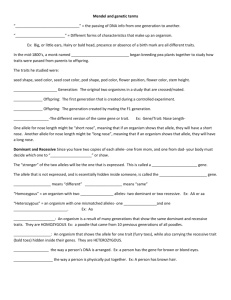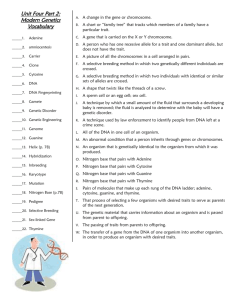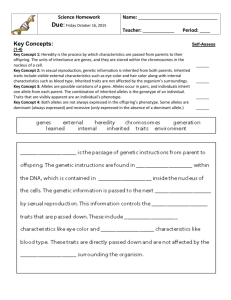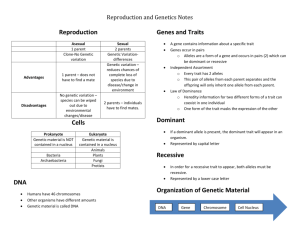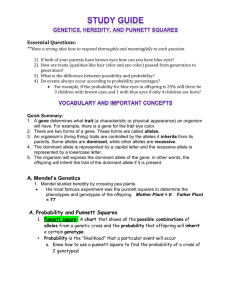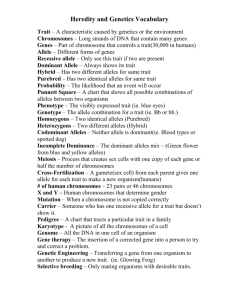VOCAB - SJSEighthGradePortfolio1027
advertisement
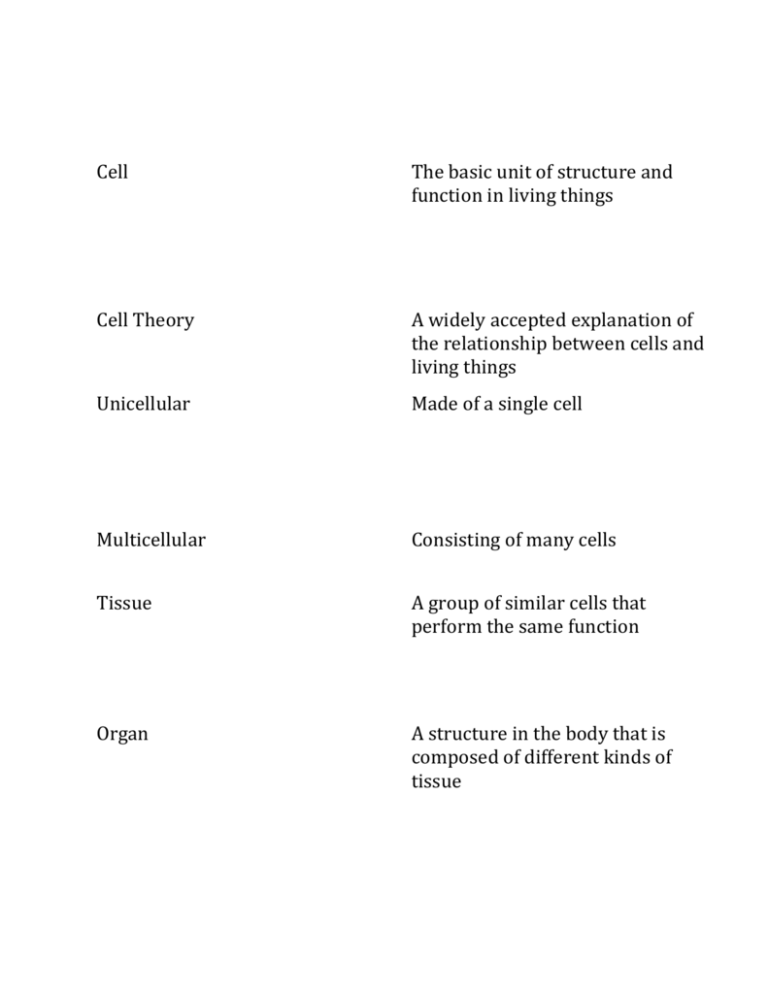
Cell The basic unit of structure and function in living things Cell Theory A widely accepted explanation of the relationship between cells and living things Unicellular Made of a single cell Multicellular Consisting of many cells Tissue A group of similar cells that perform the same function Organ A structure in the body that is composed of different kinds of tissue Organ System A group of organs that work together to perform a major function in the body Organelle A tiny structure that carries out a specific function within the cell Cell Wall A rigid layer of nonliving material that surrounds the cells of plants and some other organisms Cytoskeleton A protein “framework” inside the cell that gives the cell a shape Cell Membrane The outside cell boundary that controls which substances can enter or leave the cell Nucleus The control center of a eukaryotic cell that directs the cell’s activities and contains the information that determines the cell’s form and function Cytoplasm The material within a cell apart from the nucleus Mitochondria Rod-shaped cell structures that convert energy in food molecules to energy the cell can use to carry out its functions Endoplasmic Reticulum A cell structure that forms passageways in which proteins and other materials are carried through the cell Ribosome A small grain-like structure in the cytoplasm of a cell where proteins are made Golgi Body A structure in a cell that receives proteins and other newly formed materials from the endoplasmic reticulum, packages them, and distributes them to other parts of the cell Chloroplast A structure in the cells of plants and some n other organisms that captures energy from sunlight and uses it to produce food Vacuole A sac inside a cell that acts as a storage area Liposome A small, round cell structure containing chemicals that break down large food particles into smaller ones Element Any substance that cannot be broken down into simpler substances Compound Two or more elements that are chemically combined Carbohydrate An energy-rich organic compound made of the elements carbon, hydrogen, and oxygen Protein Large organic molecule made of carbon, hydrogen, oxygen, nitrogen, and sometimes sulfur Amino Acid A small molecule that is linked chemically to other amino acids to form proteins Enzyme A protein that speeds up chemical reactions in a living thing Lipid Energy-rich organic compound, such as a fat, oil, or wax, that is made of carbon, hydrogen, and oxygen Nucleic Acid Very large organic molecule made of carbon, oxygen, hydrogen, nitrogen, and phosphorus, that contains the instructions cells need to carry out all functions of life DNA Deoxyribonucleic acid; the genetic material that carries information about an organism and is passed from parent to offspring RNA Ribonucleic acid; a nucleic acid that plays an important role in the production of proteins Selectively Permeable A property of cell membranes that allows some substances to pass through, while others cannot Diffusion The process by which molecules move from an area of higher concentration to an area of lower concentration Osmosis The diffusion of water molecules through a selectively permeable membrane Passive Transport The movement of materials through a cell membrane without using the cell’s energy Active Transport The movement of materials through a membrane using energy Photosynthesis The process by which a cell captures energy in sunlight and uses it to make food Autotrophy An organism that makes its own food Heterotrophy An organism that cannot make its own food Pigment A colored chemical compound that absorbs light and can be used to color other materials Chlorophyll The main photosynthetic pigment found in the chloroplasts of plants, algae, and some bacteria Stomata Small opening on a leaf through which oxygen and carbon dioxide can move Respiration The process by which cells break down simple food molecules such as glucose to release the energy they contain Fermentation The process by which cells break down molecules to release energy without using oxygen Cell Cycle The regular sequence of growth and division that cells undergo Interphase The stage of the cell cycle that takes place before cell division occurs Replication The process by which a cell makes a copy of the DNA in its nucleus Mitosis The stage of the cell cycle during which the cell’s nucleus divides into two new nuclei and one copy of the DNA is distributed into each daughter cell Chromosome A doubled rod of condensed chromatin Cytokinesis The final stage of the cell cycle, in which the cell’s cytoplasm divides, distributing the organelles into each of the two new cells Differentiation The process by which cells change in structure and become capable of carrying out specialized functions Stem Cell A cell that can differentiate throughout life Heredity The passing of traits from parents to offspring Trait A characteristic that an organism can pass on to its offspring through its genes Genetics The scientific study of heredity Fertilization The joining of sperm and an egg Purebred The offspring of many generations that have the same traits Gene The set of information that controls a trait; a segment of DNA on a chromosome that codes for a specific trait Alleles The different forms of a gene Dominant Allele An allele whose trait always shows up in the organism when the allele is present Recessive Allele An allele that is masked when a dominant allele is present Hybrid An organism that has two different alleles for a trait; an organism that is heterozygous for a particular trait Probability A number that describes how likely it is that an event will occur Punnett Square A chart that shows all the possible combinations of alleles that can result from a genetic cross Phenotype An organism’s physical appearance, or visible traits Genotype An organism’s genetic makeup, or allele combinations Homozygous Having two identical alleles for that trait Heterozygous Having two different alleles for a trait Codominance A condition in which neither of two alleles of a gene is dominant or recessive Sexual Reproduction A reproductive process that involves two parents that combine their genetic material to produce a new organism, which differs from both parents Diploid Describes a cell that has two sets of chromosomes, one from each parent Meiosis The process that occurs in the formation of sex cells (sperm and egg) by which the number of chromosomes is reduced by half Messenger RNA RNA that copies the coded message from DNA in the nucleus and carries the message into the cytoplasm Transfer DNA RNA in the cytoplasm that carries an amino acid to the ribosome and adds it to the growing protein chain Mutation A change in a gene on chromosome Multiple Alleles Three or more forms of a gene that code for a single trait Sex Chromosomes A pair of chromosomes carrying genes that determine whether a person is male or female Sex-linked Gene A gene that is carried on the X or Y chromosome Carrier A person who has one recessive allele for a trait, but does not have the trait Genetic Disorder An abnormal condition that a person inherits through genes or chromosomes Pedigree A chart or “family tree” that tracks which members of a family have a particular trait Cerotype A picture of all chromosomes in a cell arranged in pairs Selective Breeding The process of selecting a few organisms with desire traits to serve as parents of the next generation Inbreeding A selective breeding method in which two individuals with identical or similar alleles are crossed Hybridization A selective breeding method in which two genetically different individuals are crossed Clone An organism that is genetically identical to the organism from which it was produced Genetic Engineering The transfer of a gene from the DNA of one organism into another organism, in order to produce an organism with desired traits Gene Therapy The insertion of working copies of a gene into the cells of a person with a genetic disorder in an attempt to correct the disorder Genome All of the DNA in one cell of an organism




